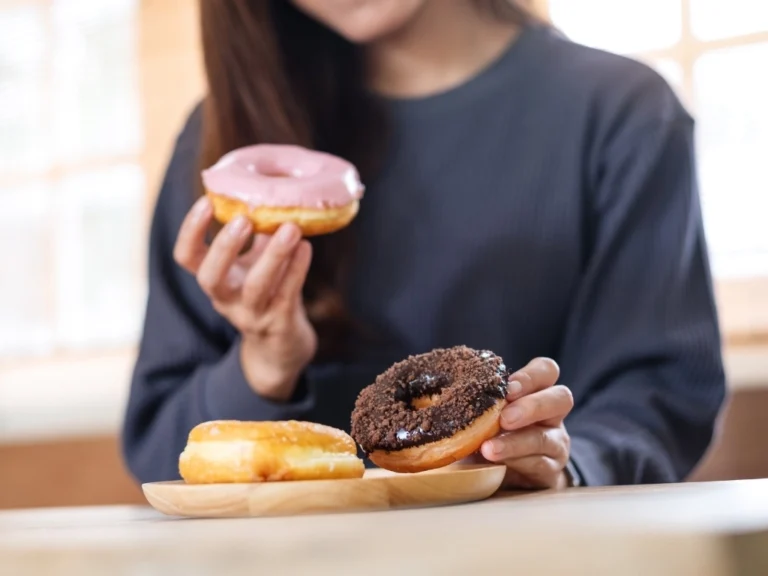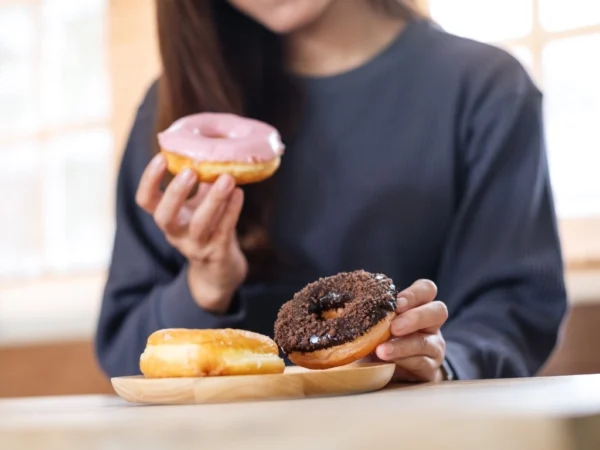Small Intestinal Bacterial Overgrowth (SIBO) can make eating feel unpredictable. Foods that seem healthy for most people — fruits, vegetables, and whole grains — can trigger bloating, gas, and discomfort. When bacteria overgrow in the small intestine, these bacteria ferment carbohydrates and other compounds before the body can absorb them, leading to digestive distress.
While treatment often involves medication and lifestyle adjustments, knowing the foods to avoid with SIBO is one of the most effective ways to control symptoms. The right diet helps starve excess bacteria while keeping your gut nourished and balanced.

Why a diet can worsen SIBO
When everything is working normally, nutrients from food should be easily absorbed in the small intestine. But with SIBO, bacteria from the large intestine move into the small intestine and start fermenting carbohydrates too early in the digestive process.
This creates hydrogen or hydrogen sulfide gas (produced by bacteria), or methane gas (produced by archaea)—each linked to different symptoms.
Understanding what makes SIBO worse starts with recognizing how certain foods feed these microorganisms. Carbohydrate-rich and high-FODMAP foods, for instance, act as fuel for fermentation. Excess sugar, fiber, and sulfur compounds can also worsen symptoms, depending on the dominant gas type.
In hydrogen-dominant SIBO, bloating and diarrhea are common. Methane-dominant SIBO (now often called Intestinal Methanogen Overgrowth or IMO) often causes constipation and sluggish digestion. Identifying the foods that intensify these patterns allows you to make strategic choices—rather than cutting out foods at random.
Major food categories to avoid with SIBO
When managing SIBO, food choices play a central role in symptom control and recovery. The goal is to limit foods that feed bacterial overgrowth, slow intestinal motility, or cause fermentation in the small intestine. Although every individual’s tolerance can differ, the following food groups are commonly associated with symptom flare-ups and should be approached with caution.
High-FODMAP foods
These short-chain carbohydrates are poorly absorbed in the small intestine, becoming a fuel source for microbes in the small bowel and triggering gas production, bloating, and pain.
Did you know?
FODMAP stands for Fermentable Oligosaccharides, Disaccharides, Monosaccharides, and Polyols
Common high-FODMAP foods include:
- Fruits: Apples, pears, cherries, mangoes, and watermelon.
- Vegetables: Onions, garlic, cauliflower, asparagus, and the stalks of broccoli and Brussels sprouts (florets are often tolerated in small amounts).
- Grains: Wheat, rye, and barley (often found in bread, pasta, and cereals).
- Sweeteners: Honey, agave syrup, sorbitol, mannitol, and xylitol.
- Legumes and beans (Oligosaccharides): Kidney beans, black beans, lentils, and chickpeas are high in oligosaccharides and resistant starch, making them notorious SIBO triggers. Even after reintroduction, soaking and pressure-cooking may be needed.
- Dairy products (Lactose): Lactose, found in milk and soft cheeses, can worsen SIBO due to fermentation. Many SIBO patients develop temporary secondary lactose intolerance. Switch to lactose-free dairy or aged cheeses (like cheddar, Swiss) and fermented dairy (Greek yogurt) as they contain less lactose.
Clinical research supports the use of low-FODMAP diets to reduce gastrointestinal symptoms in SIBO and IBS patients. However, this approach should be short-term and medically supervised. Prolonged restriction of FODMAPs can negatively impact beneficial gut bacteria and lead to nutrient deficiencies. The goal should be to identify the foods to avoid with SIBO that personally trigger your symptoms, rather than eliminate entire food groups permanently.
High-Fiber and Resistant Starch Foods
Although fiber supports gut health in the long run, excessive or poorly tolerated types of fiber can exacerbate symptoms. Insoluble fiber (which acts as roughage) and resistant starches (which ferment slowly) can be particularly problematic because they remain longer in the gut, providing more food for microbes.
Limit foods such as:
- Raw cruciferous vegetables: Cabbage, kale, and large amounts of raw broccoli (cooking these foods can significantly improve tolerance).
- High-fiber grains: Bran cereals and coarse whole wheat products.
- Cooked and cooled starches: Cold potatoes, rice, or pasta salads, as cooling increases their resistant starch content.
- Popcorn: Its hulls are pure insoluble fiber, which can irritate the gut lining when motility is sluggish.

Methane-promoting foods (IMO)
Individuals with methane-dominant SIBO (IMO) experience constipation, bloating, and very slow transit time. While the low-FODMAP diet is the primary treatment, specific foods can encourage the growth of methane-producing archaea..
It’s best to minimize:
- High-fat foods: Large servings of fatty meats, processed sausages, or high-fat dairy, as fat slows down the transit time of food through the gut, worsening constipation.
- High resistant starch foods: Starchy vegetables like potatoes and corn, or legumes, especially when consumed in large portions.
- Highly processed foods: These often contain concentrated sugars and oils that can feed gut microbes while providing little nutritional value.
Reducing these triggers helps lower microbial load and promotes better bowel regularity. Medical professionals may recommend specific diets or antibiotics designed for IMO, often alongside targeted nutrition adjustments.
Processed Snacks and Artificial Ingredients
Many processed foods contain hidden triggers for SIBO that aren’t sugars or FODMAPs. These ingredients can still disrupt digestion and slow down the healing process.
Minimize or avoid:
- Artificial sweeteners: Non-sugar sweeteners like sucralose, saccharin, and aspartame can negatively impact the gut microbiome and cause digestive distress.
- Food additives: Ingredients like carrageenan, gums, and emulsifiers, which are often used in protein bars and shakes, can irritate the intestinal lining.
- Concentrated fruit: Fruit juices and dried fruits, which are concentrated sources of fast-fermenting fructose.
Minimizing processed foods allows the digestive system to rest and recover, while also making it easier to identify personal trigger foods through elimination and symptom tracking.
Strategy for avoidance and reintroduction
Eliminating foods to avoid with SIBO shouldn’t mean adopting an overly restrictive diet. The goal is to calm your symptoms while maintaining good nutrition. Here’s a practical approach:
- Start with elimination – Temporarily remove high-FODMAP, high-sugar, and high-sulfur foods for about 2–6 weeks.
- Keep a symptom journal – Track how you feel after each meal. Note energy levels, bloating, and bowel changes.
- Reintroduce systematically – Add back one food at a time in small portions. This helps pinpoint personal triggers without cutting out entire food groups unnecessarily.
- Work with a registered nutritionist – Professional guidance ensures you’re getting balanced nutrients, especially since SIBO can impair absorption of B12, iron, and fat-soluble vitamins.
A structured reintroduction process reduces the risk of long-term nutrient deficiencies while helping you discover which foods your gut can tolerate as it heals.4
When diet alone isn’t enough
While identifying the foods to avoid with SIBO is essential, diet alone often isn’t enough to eliminate bacterial overgrowth. Some people may need antibiotics, herbal antimicrobials, or prokinetic agents to restore balance.
Addressing underlying causes — such as poor gut motility, stress, or thyroid issues — is key to preventing recurrence. Over-restriction can backfire, leading to nutrient loss and frustration. SIBO-specific counseling offers both accountability and expertise, ensuring that your meal plan evolves as your gut improves.
Work with a nutrition expert who understands SIBO
Managing SIBO can feel overwhelming without the right support. Trying to figure out which foods to avoid with SIBO on your own can quickly become confusing—and overly restrictive eating can make recovery harder. A registered nutritionist can help you design a plan that reduces symptoms while maintaining energy, supporting gut healing, and encouraging long-term balance.
If you’re ready to take control of your symptoms and rebuild confidence in what you eat, connect with a registered SIBO dietitian or nutritionist at Health Loft. Our team specializes in gut health and personalized nutrition counseling for SIBO and related digestive conditions. With expert guidance, you can pinpoint your trigger foods, plan safe reintroductions, and achieve sustainable relief—without feeling deprived.

Frequently asked questions (FAQs)
Is sugar bad for SIBO?
- Sugar can worsen SIBO symptoms because it provides a quick energy source for bacteria in the small intestine, leading to increased gas and fermentation. Natural sugars from fruit may also trigger symptoms if eaten in large quantities. That said, these foods aren’t inherently “bad” — they may just need to be limited while SIBO is active.
Is coffee bad for SIBO?
- It depends. Some people tolerate small amounts of black coffee, but it can irritate the gut and stimulate unwanted motility. If it worsens your bloating or pain, reduce or switch to herbal teas.
Is popcorn bad for SIBO?
- Often, yes. Popcorn’s rough fiber and hulls are difficult to digest, especially when gut motility is sluggish. Choose easier snacks like rice cakes or baked root vegetables instead.
Are beans bad for SIBO?
- Most beans are high in FODMAPs and can worsen bloating and gas. Some may tolerate lentils or canned chickpeas in small portions after treatment, but reintroduce them slowly.
Are cherries bad for SIBO?
- Cherries are high in fructose and polyols, both of which feed bacteria in the small intestine. It’s best to avoid them during the elimination phase and test tolerance later.
Methane SIBO foods to avoid — what are they?
- For methane-dominant SIBO (IMO), the focus is often on treating constipation. While the low-FODMAP diet is crucial, you should specifically limit resistant starches (like cooked and cooled potatoes/rice) and large portions of fatty foods, as these slow transit time and promote methane production.













